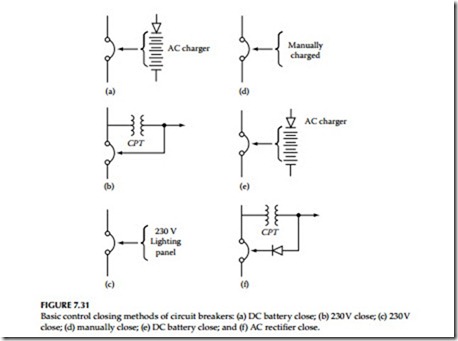AC Methods of Tripping
The AC methods of tripping are used when sufficient current is always available during fault conditions. The tripping energy is obtained from the faulted circuit via the current transformers. This tripping is always associated with overcurrent protection. A potential trip coil is provided for each breaker for normal switching operations through a breaker control switch. The following AC trips are used in switchgear:
• AC shunt trip
• Circuit opening relays
• Tripping transformers
In the AC tripping schemes, three AC trip coils are used, one in each phase to ensure that under all fault conditions the breaker will have adequate cur- rent to trip. The AC trip circuits are shown in Figure 7.30c through e.
Circuit Breaker Closing
The closing power for a circuit breaker can be either DC or AC voltage. However, it is desirable to have closing power independent of voltage conditions on the power system. For this reason the DC battery is a preferable source of closing power. The choice may be dependent on economics, par- ticularly where the switchgear consists of only a few circuit breakers or the investment in battery power could not be justified. The factors that influence the choice of closing power are the following:
• Need to close breakers with power system de-energized
• Maintenance of the closing power
• Availability of space to house the control power equipment
• Degree of reliability required
• Expansion plans
All these factors must be considered in the evaluation of the closing power before a final decision is made on what equipment is best suited for a particular installation. The following basic methods for closing power are available for switchgear applications:
2. Solenoid-operated mechanism
a. Manually (stored-energy close)
b. DC battery close
c. 230 V AC rectifier close
The basic methods of closing circuit breakers are shown in Figure 7.31a through f. The current required for closing of stored-energy-mechanism breakers can be either DC or AC. The power required for the next close operation is stored in the springs with the preceding close operation of the breaker. The AC power must be present to initiate the control circuit to the spring-release solenoid for automatic close operation of the breaker. For non- automatic operation, the spring release can be initiated manually. If needed, the stored-energy breaker close mechanism can be manually charged. The AC source for solenoid breakers requires a separate closing rectifier for each breaker.
When selecting a control power source for breaker closing, the maximum closing load must be calculated. The number of breakers required for simultaneous closing must be known so that the system can provide the required energy. In addition, any other loads that are connected to the system must be known. The selection of control power involves the sizing and selection of DC battery and AC control power transformer equipment.
